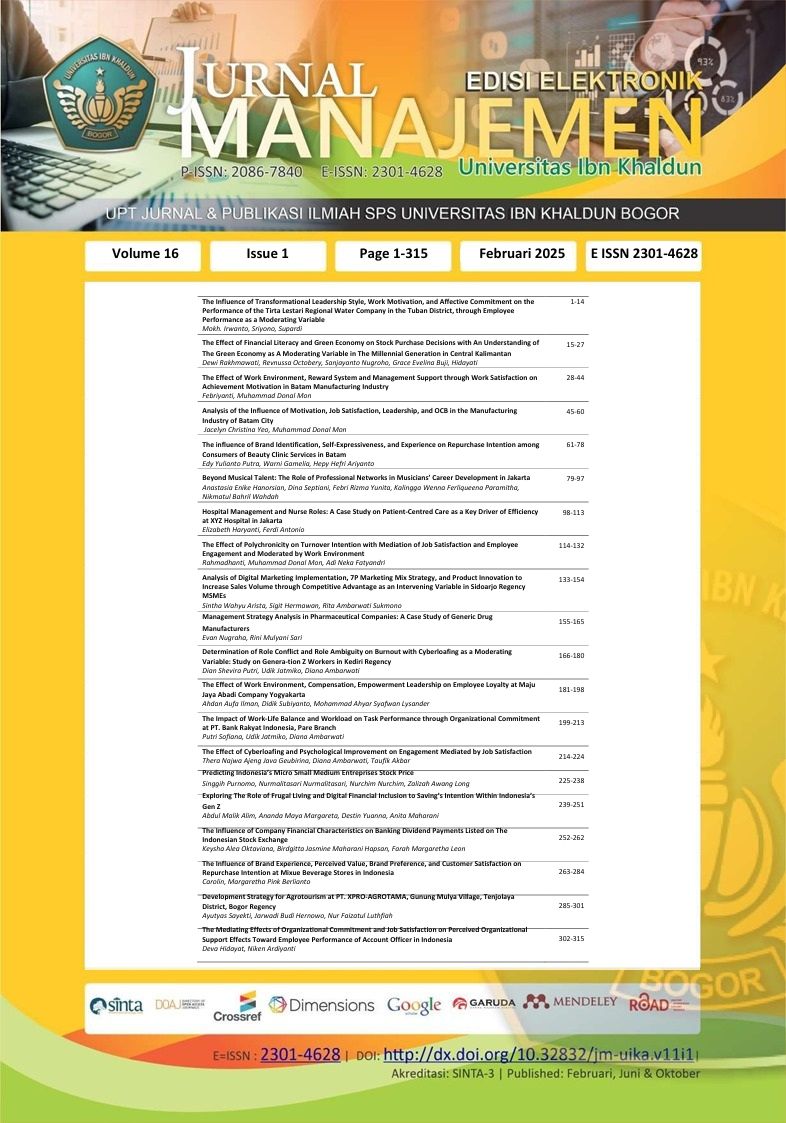The Mediating Effects of Organizational Commitment and Job Satisfaction on Perceived Organizational Support Effects Toward Employee Performance of Account Officer in Indonesia
DOI:
https://doi.org/10.32832/jm-uika.v16i1.18547Keywords:
Perceived Organizational Support, Organizational Commitment, Job Satisfaction, Employee Productivity, BankingAbstract
Employee performance is one of the factors that has attracted at-tention in the banking industry. The finance-to-deposit ratio of the banking industry in Indonesia has been growing since 2023. How-ever, along with that growth, the number of nonperforming loans also keeps rising. Moreover, the MSME credit portion hasn’t reached the targeted point of 30%. Account Officers play a vital role in the micro and MSME segment distribution. Data is collect-ed from 381 bank account officers. This study aims to examine the effects of perceived organizational support on job satisfaction, organizational commitment, and employee performance. A partial mediating effect of organizational commitment and job satisfaction was also found in the relationship between perceived organiza-tional commitment and employee performance. The result of this research is that it gives insight into how banking companies are able to improve employee performance.
References
Aggarwal-Gupta, M., Vohra, N., & Bhatnagar, D. (2010). Perceived Organizational Support and Organizational Commitment: The Mediational Influence of Psychological Well-Being. Journal of Business and Management, 2.
Akhter, A., Karim, M. M., & Islam, K. M. A. (2021). The impact of emotional intelligence, em-ployee empowerment, and cultural intelligence on commercial bank employees’ job satis-faction. Banks and Bank Systems, 16(4), 11–21. https://doi.org/10.21511/bbs.16(4).2021.02
Allen, N. J., & Meyer, J. P. (1990). The measurement and antecedents of affective, continuance, and normative commitment to the organization. Journal of Occupational Psychology, 63(1), 1–18. https://doi.org/10.1111/j.2044-8325.1990.tb00506.x
Anitha. (2014). Determinants of employee engagement and their impact on employee perfor-mance. International Journal of Productivity and Performance Management, 63(3), 308–323. https://doi.org/10.1108/IJPPM-01-2013-0008
Armstrong, & Michael. (2021). Armstrong’s Handbook of Strategic Human Resource Manage-ment. Retrieved from www.koganpage.com
Armstrong‐Stassen, M. (1998). Downsizing the Federal Government: A Longitudinal Study of Managers’ Reactions. Canadian Journal of Administrative Sciences / Revue Canadienne Des Sciences de l’Administration, 15(4), 310–321. https://doi.org/10.1111/j.1936-4490.1998.tb00173.x
Aung, Z. M., Santoso, D. S., & Dodanwala, T. C. (2023). Effects of demotivational managerial practices on job satisfaction and job performance: Empirical evidence from Myanmar’s construction industry. Journal of Engineering and Technology Management - JET-M, 67. https://doi.org/10.1016/j.jengtecman.2022.101730
Becker, H. S. (1960). Notes on the Concept of Commitment Author ( s ): Howard S . Becker Source : American Journal of Sociology , Vol . 66 , No . 1 ( Jul ., 1960 ), pp . 32-40 Pub-lished by : The University of Chicago Press Stable URL : http://www.jstor.org/stable/2773219. American Journal of Sociology, 66(1), 32–42.
Cesário, F., & Chambel, M. J. (2017). Linking Organizational Commitment and Work Engage-ment to Employee Performance. Knowledge and Process Management, 24(2), 152–158. https://doi.org/10.1002/kpm.1542
Eder, P., & Eisenberger, R. (2008). Perceived organizational support: Reducing the negative in-fluence of coworker withdrawal behavior. Journal of Management, 34(1), 55–68. https://doi.org/10.1177/0149206307309259
Eisenberger, R., Curnmings, J., Armeli, S., & Lynch, P. (1997). Perceived Organizational Sup-port, Discretionary Treatment, and Job Satisfaction. In Applied Psychology (Vol. 82).
Eisenberger, R., Fasolo, P., & Davis-Lamastro, V. (1990). Perceived Organizational Support and Employee Diligence, Commitment, and Innovation. In Journal of Applied Psychology (Vol. 75).
Girdwichai, L., & Sriviboon, C. (2020). Employee motivation and performance: Do the work environment and the training matter? Journal of Security and Sustainability Issues, 9, 42–54. https://doi.org/10.9770/JSSI.2020.9.J(4)
Hair, J. F., Black, W. C., Babin, B. J., Anderson, R. E., Black, W. C., & Anderson, R. E. (2018). Multivariate Data Analysis (Eight edit). Hampshire: Cengage Learning. https://doi.org/10.1002/9781119409137.ch4
Hempton, R. W. and B. M., & Komives, J. P. D. and S. R. M. (2008). Cultural Differences: Why Do Asians Avoid Extreme Responses? Survey Practice, 1(3), 1–7. https://doi.org/10.29115/sp-2008-0011
Judge, T. A., Thoresen, C. J., Bono, J. E., & Patton, G. K. (2001). The Job Satisfaction-Job Per-formance Relationship: A Qualitative and Quantitative Review. In Psychological Bulletin (Vol. 127).
Kreitner, R., & Kinicki, A. (2013). Organizational Behavior Tenth Edition. In Organizational Behavior: Securing Competitive Advantage.
Lisan, W., Sepang, J., & Sendow, G. (2016). Analisis Pengaruh Turnover Karyawan, Motivasi, Dan Pengayaan Pekerjaan, Terhadap Kepuasan Kerja Karyawan Pada PT. Enseval Mega-trading Tbk Manado. Jurnal Berkala Ilmiah Efisiensi, 16(3), 419–426.
Matagi, L., Baguma, P., & Baluku, M. M. (2022). Age, job involvement and job satisfaction as predictors of job performance among local government employees in Uganda. Journal of Organizational Effectiveness, 9(3), 489–505. https://doi.org/10.1108/JOEPP-06-2020-0099
Meyer, J. P., Stanley, D. J., Herscovitch, L., & Topolnytsky, L. (2002). Affective, continuance, and normative commitment to the organization: A meta-analysis of antecedents, correlates, and consequences. Journal of Vocational Behavior, 61(1), 20–52. https://doi.org/10.1006/jvbe.2001.1842
Naidoo, S., & Govender, K. K. (2022). Exploring the Relationship between Organizational Cul-ture, Organizational Commitment and Performance in Commercial Banks in Two African Countries. International Review of Management and Marketing, 12(6), 64–76. https://doi.org/10.32479/irmm.13795
OCBC. (2024, May 8). Mengenal Account Officer Bank, Tugas dan Kisaran Gajinya.
Octaviano, A. (2024, February 20). Porsi Kredit UMKM Baru 19%, Akankah Mampu Capai Target Hingga 30% di 2024? Retrieved November 22, 2024, from Kontan.co.id website: https://keuangan.kontan.co.id/news/porsi-kredit-umkm-baru-19-akankah-mampu-capai-target-hingga-30-di-2024
OJK. (2024). Statistik Perbankan Agustus. Jakarta. Retrieved from www.ojk.go.id
Pang, K., & Lu, C. S. (2018). Organizational motivation, employee job satisfaction and organiza-tional performance: An empirical study of container shipping companies in Taiwan. Mari-time Business Review, 3(1), 36–52. https://doi.org/10.1108/MABR-03-2018-0007
Pattnaik, L., Mishra, S., & Tripathy, S. K. (2023). Perceived Organizational Support and Organi-zational Commitment: Moderating Role of Person–Organization Fit. Global Business Re-view, 24(5), 902–915. https://doi.org/10.1177/0972150920920776
Rhoades, L., & Eisenberger, R. (2002). Perceived organizational support: A review of the litera-ture. Journal of Applied Psychology, 87(4), 698–714. https://doi.org/10.1037/0021-9010.87.4.698
Rojikinnor, R., Gani, A. J. A., Saleh, C., & Amin, F. (2023). The Role of Compensation As a Determinant of Performance and Employee Work Satisfaction: A Study at The PT Bank Rakyat Indonesia (Persero) Tbk. Journal of Economic and Administrative Sciences, 39(4), 943–956. https://doi.org/10.1108/JEAS-06-2020-0103
Rotundo, M. (2002). The relative importance of task, citizenship, and counterproductive per-formance to global ratings of job performance: a policy-capturing approach. The Journal of Applied Psychology, 87(1), 66–80. https://doi.org/10.1037/0021-9010.87.1.66
Sabir, I., Ali, I., Majid, M. B., Sabir, N., Mehmood, H., Rehman, A. U., & Nawaz, F. (2022). Impact of perceived organizational support on employee performance in IT firms – a com-parison among Pakistan and Saudi Arabia. International Journal of Organizational Analy-sis, 30(3), 795–815. https://doi.org/10.1108/IJOA-10-2019-1914
Sekaran, U., & Bougie, R. (2016). Research Methods for Business. West Sussex: John Willey & Sons Ltd.
Sheikh, A. M. (2023). Impact of perceived organizational support on organizational commitment of banking employees: role of work-life balance. Journal of Asia Business Studies, 17(1), 79–99. https://doi.org/10.1108/JABS-02-2021-0071
Sinval, J., & Marôco, J. (2020). Short index of job satisfaction: Validity evidence from Portugal and Brazil. PLoS ONE, 15(4). https://doi.org/10.1371/journal.pone.0231474
Spector, P. E. (1997). Job Satisfaction: Application, assessment, causes, and consequences. Beverly Hills, CA: SA.
Sulaeman, M. M., Haryono, T., Sunaryo, S., Hendarsjah, H., Riani, A. L., & Wahyuni, S. (2024). TRANSFORMATIONAL LEADERSHIP, PERCEIVED ORGANIZATIONAL SUPPORT SHARING, ORGANIZATIONAL COMMITMENT AND EMPLOYEE PERFORMANCE: THE ROLE OF RELIGIOSITY. Revista de Gestao Social e Ambiental , 18(4). https://doi.org/10.24857/rgsa.v18n4-112
Thatcher, J. B., Stepina, L. P., & Boyle, R. J. (2002). Turnover of information technology work-ers: Examining empirically the influence of attitudes, job characteristics, and external mar-kets. Journal of Management Information Systems, 19(3), 231–261. https://doi.org/10.1080/07421222.2002.11045736
Widyastuti, T., & Hidayat, R. (2018). Adaptation of Individual Work Performance Question-naire (IWPQ) into Bahasa Indonesia. International Journal of Research Studies in Psychol-ogy, 7(2). https://doi.org/10.5861/ijrsp.2018.3020
Xu, X., Zhou, L., Ampon-Wireko, S., & Quansah, P. E. (2023). Assessing the mediating role of motivation in the relationship between perceived management support and perceived job satisfaction among family doctors in Jiangsu province, China. Human Resources for Health, 21(1). https://doi.org/10.1186/s12960-023-00849-x
Zagenczyk, T. J., Purvis, R. L., Cruz, K. S., Thoroughgood, C. N., & Sawyer, K. B. (2021). Con-text and social exchange: perceived ethical climate strengthens the relationships between perceived organizational support and organizational identification and commitment. Inter-national Journal of Human Resource Management, 32(22), 4752–4771. https://doi.org/10.1080/09585192.2019.1706618
Downloads
Published
How to Cite
Issue
Section
License
Copyright (c) 2024 Jurnal Manajemen

This work is licensed under a Creative Commons Attribution-NonCommercial 4.0 International License.
Authors who publish with this journal agree to the following terms:
- Authors retain copyright and grant the journal right of first publication with the work simultaneously licensed under a Creative Commons Attribution-NonCommercial-ShareAlike 4.0 International License that allows others to share the work with an acknowledgement of the work's authorship and initial publication in this journal.
- Authors can enter into separate, additional contractual arrangements for the non-exclusive distribution of the journal's published version of the work (e.g., post it to an institutional repository or publish it in a book), with an acknowledgement of its initial publication in this journal.
- Authors are permitted and encouraged to post their work online (e.g., in institutional repositories or on their website) prior to and during the submission process, as it can lead to productive exchanges, as well as earlier and greater citation of published work (See The Effect of Open Access).











